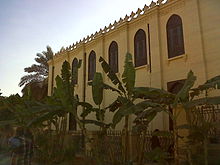Ben Ezra Synagogue
| Ben Ezra Synagogue | |
|---|---|

Ben Ezra Synagogue, Old Cairo
|
|
| Basic information | |
| Location | Cairo, Egypt |
| Geographic coordinates | 30°00′21″N 31°13′52″E / 30.0057944°N 31.2310222°E |
| Affiliation | Orthodox Judaism |
| Rite | Sephardic |
| Completed | 1892 |
| Specifications | |
| Length | 17 meters (56 ft) |
| Width | 11.3 meters (37 ft) |
Coordinates: 30°00′21″N 31°13′52″E / 30.0057944°N 31.2310222°E
The Ben Ezra Synagogue (Hebrew: בית כנסת בן עזרא, Arabic: معبد بن عزرا), sometimes referred to as the El-Geniza Synagogue (Hebrew: בית כנסת אל גניזה) or the Synagogue of the Levantines (al-Shamiyin), is situated in Old Cairo, Egypt. According to local folklore, it is located on the site where baby Moses was found.
This was the synagogue whose geniza or store room was found in the 19th century to contain a treasure of abandoned Hebrew, Aramaic and Judeo-Arabic secular and sacred manuscripts. The collection, known as the Cairo Geniza, was brought to Cambridge, England at the instigation of Solomon Schechter and is now divided between several academic libraries.
Ben Ezra as an institution is ancient, and has occupied at least three buildings in its history. There have been many major and minor renovations. The current building dates to the 1890s.
The founding date of the Ben Ezra Synagogue is not known, although there is good evidence from documents found in the geniza that it predates 882 C.E. and is probably pre-Islamic. In 882, the patriarch of the Coptic Orthodox Church of Alexandria sold a church and its grounds to a group of Jews, and some 19th century scholars had assumed that this was the origin of Ben Ezra. However, the buyers were followers of the Talmudic Academies in Babylonia, and Ben Ezra was a congregation that observed the teachings of the rival Talmudic Academies in Syria Palaestina. Modern scholars agree that the 882 land sale was to a rival synagogue.
...
Wikipedia
